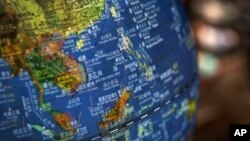As China and the Association of Southeast Asian Nations (Asean) have approved a draft of a proposed agreement to prevent conflict in the disputed South China Sea, a US official has said international norms should be incorporated in the text.
China and the 10-nation bloc, which includes four claimants involved in the territorial dispute, have been engaged in sporadic negotiations for years to craft a "code of conduct" aimed at preventing violent outbreaks in the region.
“It’s important that all countries, regardless of their size, have the opportunity to represent their national interests as well as the very clear international principles including the principles that are enshrined in [the Law of the Sea]. That position is unchanged,” US Ambassador Piper Campbell, Charge d’Affairs at the US Mission to Asean, said on Tuesday.
She added that the US was pleased that China and Asean were moving towards negotiating a code of conduct, adding that forums like the East Asia Summit provide a good opportunity for the United States to discuss the issue with their Asian partners.
“Those meetings in Singapore provided an excellent opportunity for frank and clear conversations on the situation in the South China Sea, and to raise our very real concerns about ongoing activities of militarization and to ask for clarity about how those actual steps on the ground, how those fit with the principles that were enumerated by almost every country in the discussion,” Campbell said.
Prak Sokhonn, Cambodia’s foreign minister, said that the developments were positive.
"Asean and China have demonstrated that trust combined with practical marine cooperation and credible Early Harvest and Confidence Building Measures can bring positive results."
Chheang Vannarith a regional analyst, said that both sides still need to work on the substance of the code of the conduct.
“It is a significant step in bridging the trust gap between China and Asean on the COC. However, the substance of the COC really matters,” he said.
“The US's role remains relevant in maritime security in the Asia Pacific region."
Singapore’s Foreign Minister Vivian Balakrishnan said on Thursday that the development was a "milestone."
Her Chinese counterpart, Wang Yi, said approval of the draft was "good news" and a "breakthrough."
China has transformed seven disputed reefs into man-made islands replete with three runways, surface-to-air missiles and other weapons systems.
Without naming China, Asean foreign ministers cited Beijing's actions, saying in a statement they "took note of the concerns expressed by some countries on the land reclamation in the area, which has eroded trust and confidence, increased tensions and may undermine peace, security, and stability in the region.''
China has responded to criticism by claiming it has the right to build on its territory and defend its strategic interests at all costs.
China and Taiwan, as well as Asean members Brunei, Malaysia, the Philippines and Vietnam, have all made claims in the South China Sea, a pathway for much of the commerce and oil that bolsters Asia's bustling economies.
U.S. military ships and jets patrol the waters, a presence that Washington maintains is designed to promote freedom of navigation and overflight. China contends, however, the United States is meddling in Asian affairs.
The U.S. response to China’s controversial actions in the South China Sea is “consistency,” the Navy’s top admiral has said.
Speaking in an exclusive interview with VOA, Chief of Naval Operations Adm. John Richardson said the United States Navy has been “at about the same force levels” in the South China Sea for about 70 years.
“Nothing has elevated too much or decreased too much. We've been pretty steady,” he said.









